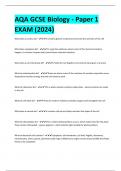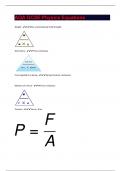Jessybrown
On this page, you find all documents, package deals, and flashcards offered by seller jessybrown.
- 2350
- 0
- 36
Community
- Followers
- Following
2386 items

AQA GCSE Biology Paper 1 - Revision Questions And Answers
How is the real size of a magnified image calculated? - Real size = Image size ÷ Total magnification. What is a eukaryotic cell? - A cell with DNA inside a membrane bound nucleus. Prokaryotic cells do not have a nucleus. Name two differences between a plant cell and a bacterial cell? - Plant cells have a nucleus / plant cells have mitochondria / plant cells have chloroplasts / plant cells have a cellulose cell wall whereas bacteria do not contain any of these structures. Bacteria have chr...
- Package deal
- Exam (elaborations)
- • 3 pages •
How is the real size of a magnified image calculated? - Real size = Image size ÷ Total magnification. What is a eukaryotic cell? - A cell with DNA inside a membrane bound nucleus. Prokaryotic cells do not have a nucleus. Name two differences between a plant cell and a bacterial cell? - Plant cells have a nucleus / plant cells have mitochondria / plant cells have chloroplasts / plant cells have a cellulose cell wall whereas bacteria do not contain any of these structures. Bacteria have chr...

AQA GCSE Biology Paper 1 - Revision Questions
How is the real size of a magnified image calculated? - Real size = Image size ÷ Total magnification. What is a eukaryotic cell? - A cell with DNA inside a membrane bound nucleus. Prokaryotic cells do not have a nucleus. Name two differences between a plant cell and a bacterial cell? - Plant cells have a nucleus / plant cells have mitochondria / plant cells have chloroplasts / plant cells have a cellulose cell wall whereas bacteria do not contain any of these structures. Bacteria have chr...
- Package deal
- Exam (elaborations)
- • 3 pages •
How is the real size of a magnified image calculated? - Real size = Image size ÷ Total magnification. What is a eukaryotic cell? - A cell with DNA inside a membrane bound nucleus. Prokaryotic cells do not have a nucleus. Name two differences between a plant cell and a bacterial cell? - Plant cells have a nucleus / plant cells have mitochondria / plant cells have chloroplasts / plant cells have a cellulose cell wall whereas bacteria do not contain any of these structures. Bacteria have chr...

AQA GCSE Biology Paper 2
What is homeostasis? - The maintenance of a constant internal environment. What is a stimulus? - A change in your environment than requires a response. e.g Light, sound, touch, pressure, pain, chemical or temperature. What do the receptors do? - Detect the stimulus or change in environment. What happens after the receptors? - Receptors send messages to the CNS via the sensory neurone. What makes up the central nervous system? - The brain or spinal cord What is an effector? - Muscles or gl...
- Package deal
- Exam (elaborations)
- • 37 pages •
What is homeostasis? - The maintenance of a constant internal environment. What is a stimulus? - A change in your environment than requires a response. e.g Light, sound, touch, pressure, pain, chemical or temperature. What do the receptors do? - Detect the stimulus or change in environment. What happens after the receptors? - Receptors send messages to the CNS via the sensory neurone. What makes up the central nervous system? - The brain or spinal cord What is an effector? - Muscles or gl...

AQA GCSE Biology - Paper 1 EXAM (2024)
What does a nucleus do? - It contains genetic material and controls the activities of the cell What does cytoplasm do? - It's a gel-like substance where most of the chemical reactions happen. It contains enzymes that control these chemical reactions What does a cell membrane do? - It holds the cell together and controls what goes in and out What do mitochondria do? - These are where most of the reactions for aerobic respiration occur. Respiration transfers energy that the cell needs to wor...
- Package deal
- Exam (elaborations)
- • 37 pages •
What does a nucleus do? - It contains genetic material and controls the activities of the cell What does cytoplasm do? - It's a gel-like substance where most of the chemical reactions happen. It contains enzymes that control these chemical reactions What does a cell membrane do? - It holds the cell together and controls what goes in and out What do mitochondria do? - These are where most of the reactions for aerobic respiration occur. Respiration transfers energy that the cell needs to wor...

AQA GCSE Chemistry - Paper 1
What is the charge of a proton? - +1 What is the charge of a neutron? - 0 What is the charge of an electron? - -1 What is the relative mass of a proton? - 1 What is the relative mass of a neutron? - 1 What is the relative mass of an electron? - Very small How many types of atoms do elements contain? - Only one type What are compounds? - Substances containing two or more different elements that are chemically bonded together What are mixtures? - Substances containing two or more differen...
- Package deal
- Exam (elaborations)
- • 29 pages •
What is the charge of a proton? - +1 What is the charge of a neutron? - 0 What is the charge of an electron? - -1 What is the relative mass of a proton? - 1 What is the relative mass of a neutron? - 1 What is the relative mass of an electron? - Very small How many types of atoms do elements contain? - Only one type What are compounds? - Substances containing two or more different elements that are chemically bonded together What are mixtures? - Substances containing two or more differen...

AQA GCSE Physics QUESTIONS AND ANSWERS
This type of surface is a good absorber and emitter of thermal radiation - Dark, rough (matt) surface This type of surface is a bad absorber and emitter of thermal radiation - Light, shiny surface In this process particles vibrate colliding with each other passing energy along. Solids are best at it, then liquids, then gases. - Conduction In this process particles move around carrying energy with them. Gases are best at it, then liquids then solids - Convection This process doesn't requi...
- Exam (elaborations)
- • 5 pages •
This type of surface is a good absorber and emitter of thermal radiation - Dark, rough (matt) surface This type of surface is a bad absorber and emitter of thermal radiation - Light, shiny surface In this process particles vibrate colliding with each other passing energy along. Solids are best at it, then liquids, then gases. - Conduction In this process particles move around carrying energy with them. Gases are best at it, then liquids then solids - Convection This process doesn't requi...

AQA GCSE Physics Equations
Weight - Mass x Gravitational Field Strength Work Done - Force x Distance Force Applied to a Spring - Spring Constant x Extension Moment of a Force - Force x Distance Pressure - Force / Area
- Exam (elaborations)
- • 4 pages •
Weight - Mass x Gravitational Field Strength Work Done - Force x Distance Force Applied to a Spring - Spring Constant x Extension Moment of a Force - Force x Distance Pressure - Force / Area

AQA GCSE Physics - Paper 1
Energy Stores - 1) Elastic potential 2) Gravitational potential 3) Thermal 4) Electrostatic 5) Nuclear 6) Chemical 7) Kinetic 8) Magnetic 9) Light 10) Sound How is energy transferred? - 1) Mechanically - force doing work 2) Electrically - work done by moving charges 3) Heating/Radiation - light, sound How can work be done? - When a current flows or by a force moving an object Kinetic energy formula - E=1/2mv² Kinetic energy(J) = 0.5 x mass(kg) x speed²(m/s) Gravitational potent...
- Exam (elaborations)
- • 31 pages •
Energy Stores - 1) Elastic potential 2) Gravitational potential 3) Thermal 4) Electrostatic 5) Nuclear 6) Chemical 7) Kinetic 8) Magnetic 9) Light 10) Sound How is energy transferred? - 1) Mechanically - force doing work 2) Electrically - work done by moving charges 3) Heating/Radiation - light, sound How can work be done? - When a current flows or by a force moving an object Kinetic energy formula - E=1/2mv² Kinetic energy(J) = 0.5 x mass(kg) x speed²(m/s) Gravitational potent...

AQA GCSE Triple Science - Biology
What are eukaryotic cells? - Cells that are more complex and have a nucleus (animal and plant cells) What are prokaryotic cells? - Cells that are smaller and simpler, and don't have a nucleus but still have genetic information (bacteria) What are eukaryotes? - Organisms made of eukaryotic cells What is a prokaryote? - A prokaryotic cell (it's a single celled organism) What is cytoplasm? - A liquid gel in which most of the chemical reactions needed for life take place. It contains enzymes...
- Package deal
- Exam (elaborations)
- • 48 pages •
What are eukaryotic cells? - Cells that are more complex and have a nucleus (animal and plant cells) What are prokaryotic cells? - Cells that are smaller and simpler, and don't have a nucleus but still have genetic information (bacteria) What are eukaryotes? - Organisms made of eukaryotic cells What is a prokaryote? - A prokaryotic cell (it's a single celled organism) What is cytoplasm? - A liquid gel in which most of the chemical reactions needed for life take place. It contains enzymes...

Atomic structure: Chemistry AQA: GCSE (9:1)
Relative mass of a proton 1 Relative mass of a neutron about the same as that of a proton Relative mass of an electron 1/1840 Relative charge of a proton +1 Relative charge of a neutron 0 Relative charge of an electron -1 Neutral atoms same number of positive protons as negative electrons
- Package deal
- Exam (elaborations)
- • 7 pages •
Relative mass of a proton 1 Relative mass of a neutron about the same as that of a proton Relative mass of an electron 1/1840 Relative charge of a proton +1 Relative charge of a neutron 0 Relative charge of an electron -1 Neutral atoms same number of positive protons as negative electrons
